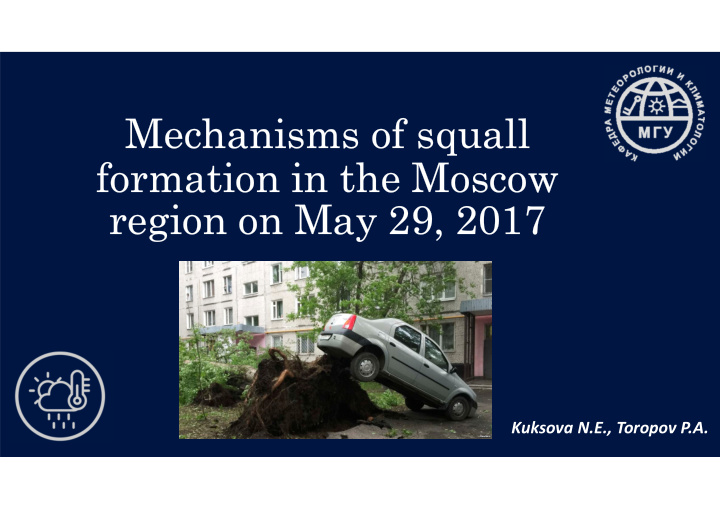



Mechanisms of squall formation in the Moscow region on May 29, 2017 Kuksova N.E., Toropov P.A.
Purpose: study of the mechanism of squally wind amplification in Moscow on May 29, 2017 Tasks: analysis of storm conditions based on station and remote observational data, as well as reanalysis data. assessment of the event reproduction based on numerical experiments using the WRF-ARW mesoscale non-hydrostatic model. formulation of a hypothesis about the physical mechanisms of the phenomenon.
Materials and methods SODAR«MODOS» АМК Vaisala MAWS-301 DMRL-С MTP-5 plofier Satellite METEOSAT-10
Severe meteorological events 700 Number of severe events 600 500 400 300 https://www.essl.org/cms/convective-windstorms-in-2017- 200 episode-1-29-may/ 100 0 ( Report on climate features in the territory of the Russian Federation for 2016. Roshydromet, 2017 )
Fron ontal analysis at sea level el pres essure 12 UTC T=15° C T=25° C
Character eristics obser erved ed by the e meteor eorolog ogical obser ervator ory of MSU 30 1015 1013 25 erature, ° С 1011 ed, m/s Pressure, 1009 20 1007 Wind speed 15 1005 Air temper 1003 e, hPa 10 1001 999 5 997 0 995 Time
Causes es of extrem eme wind gusts Strong dynamic instability Low level jet Reanalysis Critical value Wind shear 0.0027 1/s > 0.0013 1/s 25 m/s Low level jet
Mesoscale nonhydrostatic model el WRF-ARW 3 domains Grid spacing: 10, 5, 1 km Initial and boundary conditions: reanalysis ERA-Interim 0.75 °
Wind speed Observation (SODAR «MODOS») м/с Modeling
Con onclusion ons: 1. The event occurred as a result of: lowering the low level jet due to intense dynamic instability of the atmosphere downward flow on the active cold atmospheric front 2. As a result of mesoscale modeling, it was revealed that the model reproduced well the space-time structure of this phenomenon, with the exception of the temperature effect
Thanks for your attention!
Recommend
More recommend